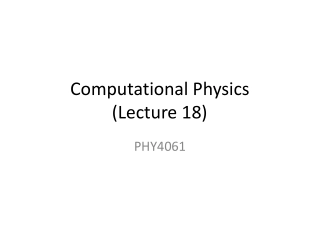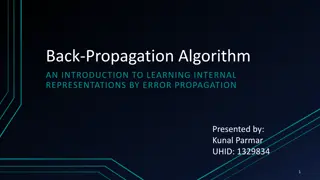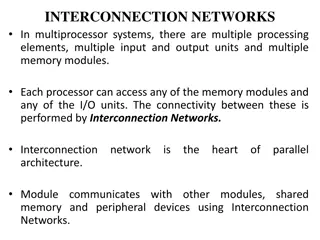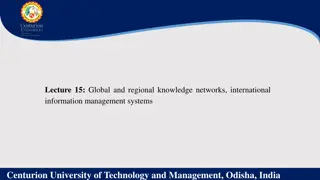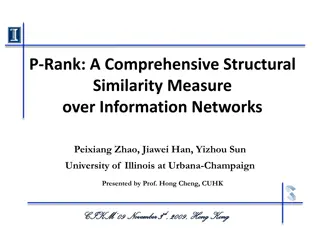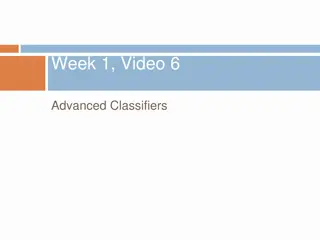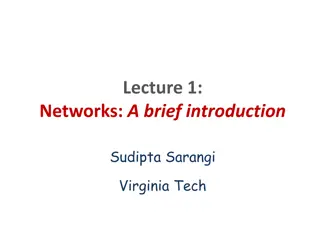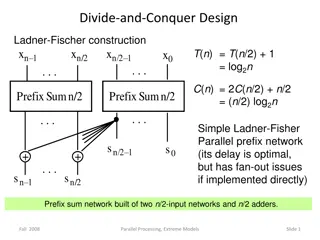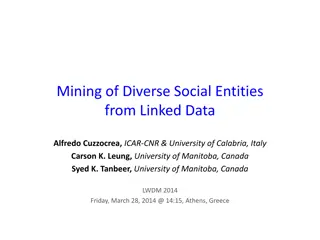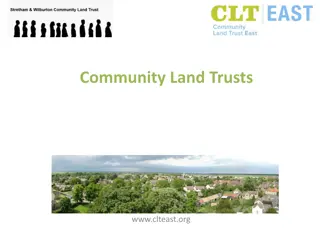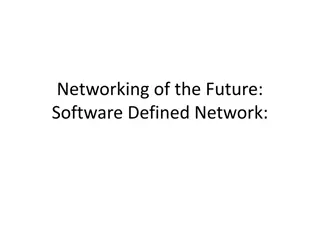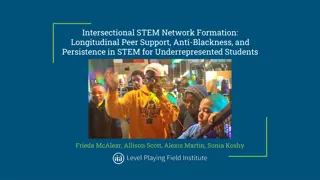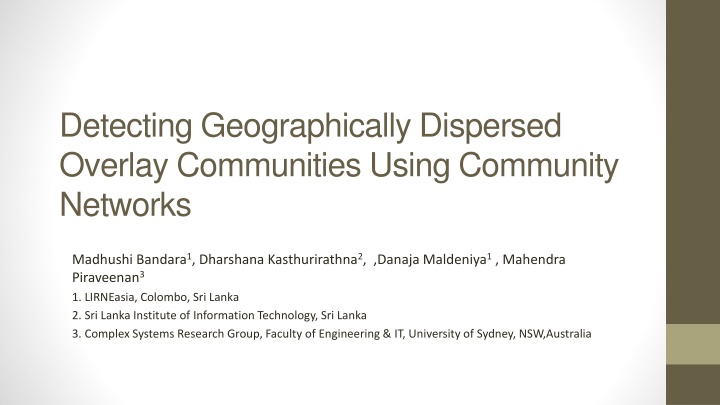
Overlay Community Detection Techniques in Network Analysis
Explore methods for detecting geographically dispersed overlay communities in network structures. Learn how community structure analysis impacts social and biological networks, and discover key techniques like modularity maximization and Newman-Girvan modularity measure.
Download Presentation

Please find below an Image/Link to download the presentation.
The content on the website is provided AS IS for your information and personal use only. It may not be sold, licensed, or shared on other websites without obtaining consent from the author. If you encounter any issues during the download, it is possible that the publisher has removed the file from their server.
You are allowed to download the files provided on this website for personal or commercial use, subject to the condition that they are used lawfully. All files are the property of their respective owners.
The content on the website is provided AS IS for your information and personal use only. It may not be sold, licensed, or shared on other websites without obtaining consent from the author.
E N D
Presentation Transcript
Detecting Geographically Dispersed Overlay Communities Using Community Networks Madhushi Bandara1, Dharshana Kasthurirathna2, ,Danaja Maldeniya1, Mahendra Piraveenan3 1. LIRNEasia, Colombo, Sri Lanka 2. Sri Lanka Institute of Information Technology, Sri Lanka 3. Complex Systems Research Group, Faculty of Engineering & IT, University of Sydney, NSW,Australia
Community structure in networks Community is a group of nodes that have a higher likelihood of connecting to each other than to nodes from other communities Has numerous applications in social networks and biological networks In social networks, understanding the underlying community structure may help to understand the social dynamics in a social group and make predictions (e.g. Zachary s Karate Club [1]) In biological networks, community structure may help to understand diseases at the cellular level and how groups of molecules carry out cellular functions
Community detection techniques Minimum-cut method The network is divided to predetermined number of groups of approximately same size, chosen such that the number of edges between groups are minimized Hierarchical Clustering A similarity measure (e.g. cosine similarity) is used to quantify similarity between node pairs Girman-Newman algorithm Identifies the edges that connect communities and removes them, based on the betweenness centrality of each edge
Modularity maximization Ideal for large, unstructured and self-organizing networks Modularity is a scale value between -1 and + 1, which measures the density of edges inside communities to edges outside communities Smaller communities are grouped into single nodes and iteratively grown into larger communities until the modularity measure is maximized Louvain method [2] produces better modularity values with higher performance
Newman-Girvan Modularity Measure The fraction of edges within communities in the observed network minus the expected value of that fraction in a null model ??.?? 2? 1 ? ? = 2? ? ? ?,? ???? ??,? ???= - - - - C is a given partition G = (V;E) where V is a set of nodes and E is a set of edges among nodes n and m represent the cardinalities of V and E respectively. ???is the weight associated to each edge (vj; vi) For a given node vi V , i= {vj| (vi; vj) E (vj; vi) E } and ki= | i|. Pijrefers to the null model that is used as a reference model, where the edges of the network are rewired randomly while preserving the degree distribution. - -
Spatial bias in community structure I call to my friends all the time, for partying, when I want a lift or to discuss homework. Alice s College Friends Does that mean my brother, whom I call twice a week, is not a part of my community? Alice s Brother - Lives in New York Alice Studies in London
Dist-Modularity [3] In many real world social/biological networks the nodes that are in close geographical proximity have a higher tendency of forming communities. Dist-modularity tries to normalize the effect of spatial bias 1 ?????? = 2? ?,? ? ??? ??,? ? ? ???.+ 2 ??? ???= ?????(? ??,??) ?? ????(? ??,??);?:?+ (0,1] ??? = f: distance decaying function d: distance between the two nodes connected by an edge
Detecting geographically dispersed communities There can be important links between communities that are geographically far apart. E.g: Migrant worker community networks and Terrorist networks Dist-modularity tries to normalize the effect of geographical proximity to extract geographically dispersed communities However, this is done at the expense of losing the information about the geographically proximate communities. (assumes the community is dispersed at the node level) Communities may be geographically dispersed at the community level and not the individual node level
Can we extract geographically dispersed communities while preserving the information about the geographically proximate communities???
Extracting geographically distributed overlay communities Extract the community set C using the Louvain method of N-G modularity optimization; for each community c in the set of communities C do 1. Identify the centroid of each community based on geographical location of each node in the community ; 2. Assign the centroid as the node representing that particular community in the community network ; for each community pair p in the set of communities C do 1. Compute the strength of the link connecting the community pair p by aggregating the connections among the nodes in community pair p ; 2. Normalize the link strengths by the community sizes by dividing the link strengths by the multiplication of community sizes of the community pair p ; Identify the communities that are relatively further apart geographically yet have relatively higher link strengths as the `overlay communities' ; 1. 2. 3. 4.
Applying to a real-world network Gowala Social Network [4] with check-in details of users 196,591 connected users with location records of 107,092 users Louvain algorithm was applied to total network data set 820 communities were detected at the highest modularity value The centroid of each resulting community was decided by home locations of members with known locations (through Check-in details)
Distribution of Community Size and Degree Evidence for scale-free characteristics of the network 6 12 5 10 No. of communities No. of communities 4 8 3 6 2 4 2 1 0 0 0 1 2 3 4 5 6 7 8 9 10 11 Community degree 1 2 3 4 5 6 7 8 9 10 11 Community size Scale-free correlation: 0.74 Scale-free exponent : 0.67
Community network with heterogeneous node sizes and normalized link strengths. The community sizes and link strengths are non-correlated
Evidence of communities that are tightly connected despite being geographically apart. 50000 0.0001 Normalised link strength 40000 Link strength 30000 20000 10000 0 0 200 Community distance 400 600 800 0 200 Community distance 400 600 800
Community Pair with a relatively high normalized link strength 253 - 585 When we normalize the tie strength by population, the link strength of these communities is higher than 82% of community pairs observed. It is important to note that these two communities are not overlapping and geographically apart Thus, we could identify this particular community pair as a geographically dispersed single overlay community.
Extracting geographically distributed overlay communities Better performance than dist-modularity optimization Time Complexity O(n log n) May be used to identify geographically dispersed communities while preserving geographically proximate communities (both may be relevant) E.g. Migrant communities, Terrorist cell networks The extracted overlay communities may be used for effective marketing campaigns, defense related applications, understanding how economies work, studying migration patterns, etc.
Future work Could be applicable in biological networks as well (e.g. Neural networks in the brain) More insights from overlay community networks? (centrality, robustness, assortativity) Other dimensions for community bias that may be considered other than spatial proximity? (e.g. income/educational level forming a bias in community structure)
Acknowledgements LIRNEasia.net International Development Research Centre (IDRC) of Canada Sri Lanka Institute of Information Technology (www.sliit.lk)
References [1] Girvan, Michelle, and Mark EJ Newman. "Community structure in social and biological networks." Proceedings of the national academy of sciences 99.12 (2002): 7821-7826. [2] De Meo, Pasquale, et al. "Generalized louvain method for community detection in large networks." Intelligent Systems Design and Applications (ISDA), 2011 11th International Conference on. IEEE, 2011. [3] Shakarian, Paulo, et al. "Mining for geographically disperse communities in social networks by leveraging distance modularity." Proceedings of the 19th ACM SIGKDD international conference on Knowledge discovery and data mining. ACM, 2013. [4] Leskovec, Jure, and Andrej Krevl. "{SNAP Datasets}:{Stanford} Large Network Dataset Collection." (2015).

